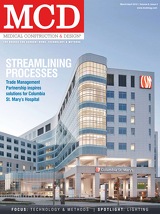Medical Construction & Design (MCD) is the industry's leading source for news and information and reaches all disciplines involved in the healthcare construction and design process. To view more past issues go to: http://mcdmag.epubxpress.com
Page 16 of 70
Green News
Three steps to greener healthcare data centers
By John Pappas W
hile healthcare facilities are working toward greener buildings and operations, not much
attention has been paid to the energy use of data centers. Compared to other industries, hospital data centers are still relatively small but growing. More importantly, energy footprints are becoming very large. The industry's movement toward
electronic medical records, as well as the increasing use of technology applications, is driving the increase in required energy. Most energy needed for a data
center, beyond that used by the technology equipment, goes to the supporting technology infrastructure. Twenty percent of this energy is for the electrical system and 80 percent is for the cooling system. Therefore, saving a large amount of energy requires improving cooling-system effi ciency.
STEP 1: Practice proper airfl ow management Reducing energy use in data centers is all about keeping hot and cold air from mixing. Helpful techniques include:
Hot and cold aisles. During in-
stallation, ensure servers are placed in a back-to-back and front-to-front "hot and cold aisle" arrangement to prevent air mixing. Another simple technique is to use aisle barriers that prevent the air from circulating around the cabinets. These can be as simple as the plastic sheets similar to those found in supermarket cold cases or can be solid barrier material. The barriers maintain the separation of the heat in the hot aisles from the cooling air in the cold aisles.
The industry's move- ment toward electronic medical records, as well as the increasing use of technology applications, is driving the increase in required energy.
12 Medical Construction & Design | March/April 2012 Floor tiles. Perforated fl oor tiles
are used to provide cooling, but must be placed in the cold aisles to direct the cool air to the front of the servers. The quantity of these tiles will vary based on the capacity of the tiles, the pressure in the raised-fl oor plenum and the loads being served. The challenge of all these variables is eliminated with the installation of a tight barrier system. Stop leakage. Server cabinets are
open boxes until fi lled with servers, but often are not completely fi lled. This leaves openings which allow hot air from the back to short circuit to the front. Fixing this can be as simple as installing "blanking panels" within server cabinets to block the short- circuiting of hot air. Return air plenum. In many data
centers the hot air return air path is between the top of the server rows and the ceiling. An enormous amount of mixing, and subsequent energy loss, occurs when this is done. Utilizing the ceiling plenum as the
www.mcdmag.com
